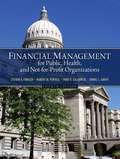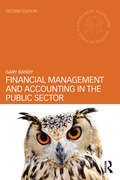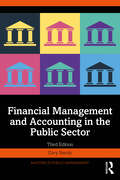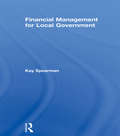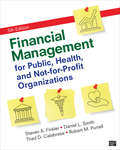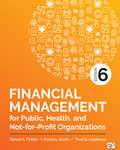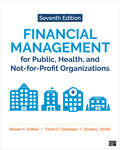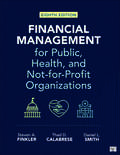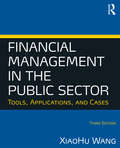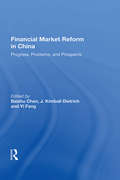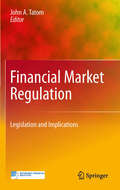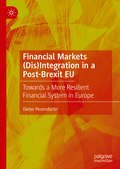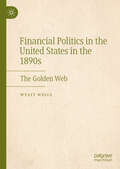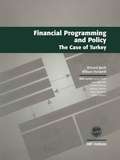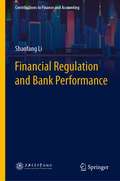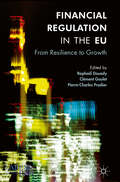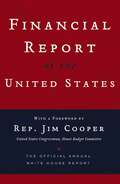- Table View
- List View
Financial Management For Public, Health, And Not-for-profit Organizations
by Steven A. Finkler Thad Calabrese Robert Purtell Daniel L. SmithOne of the few texts that addresses financial and managerial accounting within the three major areas of the public sector. Financial Management for Public, Health, and Not-for-Profit provides the fundamentals of financial management for those pursuing careers within the public, health and not-for-profit fields. With a unique presentation that explains the rules specific to the public sector, this book outlines the framework for readers to access and apply financial information more effectively.
Financial Management and Accounting in the Public Sector (Masters in Public Management)
by Gary BandyThe impact of the global financial crisis on government funds has been significant, with squeezed budgets having to satisfy ever-increasing demands for public services. Managers working in the public sector are confronted daily with targets and demands that are often set in confusing accounting and financial language. In Financial Management and Accounting in the Public Sector, Gary Bandy employs a clear and concise narrative to introduce the core concepts of accounting and financial management in the public sector and how to deliver services that represent value for money. This second edition has been revised and updated throughout, offering: an increased focus on post-crisis austerity more international examples of public financial management greater coverage of governance, accountability and risk management With a glossary of terms to help managers understand and be understood by accountants, as well as learning objectives, case studies and discussion questions, this practical textbook will help students of public management and administration to understand the financial and accounting aspects of managing public services.
Financial Management and Accounting in the Public Sector (Masters in Public Management)
by Gary BandyThe importance of public financial management for the health and wellbeing of citizens became dramatically apparent as governments sought to respond to the coronavirus pandemic in 2020. Now, governments and other public sector organizations face the challenge of recovering from the pandemic whilst also seeking to achieve Sustainable Development Goals, with squeezed budgets and ever-increasing demands for public services. Public sector managers are confronted daily with targets and demands that are often set in confusing accounting and financial language. In Financial Management and Accounting in the Public Sector, Gary Bandy employs a clear and concise narrative to introduce the core concepts of public financial management to help those managers to deliver programmes, projects and services that are value for money. As the author puts it, managing public money is an art, not a science. This third edition has been revised and updated throughout, offering: a structure that is more clearly linked to the stages of the public financial management cycle greater coverage of transparency and accountability issues a broader view of public procurement to include goods, works and services and effective contract management; and an increased focus on public spending in the context of a post-COVID environment. With a glossary of terms to help managers understand and be understood by accountants, as well as learning objectives, discussion questions and exercises, this practical textbook will help students of public management and administration to understand the financial and accounting aspects of managing public services.
Financial Management for Local Government
by Kay SpearmanThis series is designed to cover all aspects of sound financial management for local governments in developed and developing countries and economies in transition. Concepts of good governance, transparency and accountability are woven into the text of every chapter, and the needs and potential obstacles to greater decentralization and democracy are highlighted. Each volume is self-contained with its own Trainer's Guide, exercises and web resources. Chapters are divided into basic and advanced concepts and the detailed relationship of each topic to the others covered in the series is explained.
Financial Management for Public, Health, and Not-for-Profit Organizations
by Steven A. Finkler Daniel L. Smith Dr Thad D. Calabrese Robert M. PurtellNow in its Fifth Edition, Financial Management for Public, Health, and Not-for-Profit Organizations is the leading textbook on financial management in the government, health, and not-for-profit sectors providing a comprehensive yet practical introduction to the financial decision-making and management skills required of students and practitioners in the field. Assuming readers have no prior training in financial management, authors Steven A. Finkler, Daniel L. Smith, Thad D. Calabrese, and Robert M. Purtell artfully combine the principles and theory and analytics of accounting and finance. Coverage includes cost analysis, budget preparation, budget and variance analysis, management control, and recording and reporting financial information, with an emphasis on preparing and analyzing financial statements. The authors detail the foundational principles of each of the methods introduced in the book, and through step-by-step equations, figures, and exhibits, they illustrate how to execute financial management in practice.
Financial Management for Public, Health, and Not-for-Profit Organizations
by Steven A. Finkler Daniel L. Smith Dr Thad D. Calabrese Robert M. PurtellNow in its Fifth Edition, Financial Management for Public, Health, and Not-for-Profit Organizations is the leading textbook on financial management in the government, health, and not-for-profit sectors providing a comprehensive yet practical introduction to the financial decision-making and management skills required of students and practitioners in the field. Assuming readers have no prior training in financial management, authors Steven A. Finkler, Daniel L. Smith, Thad D. Calabrese, and Robert M. Purtell artfully combine the principles and theory and analytics of accounting and finance. Coverage includes cost analysis, budget preparation, budget and variance analysis, management control, and recording and reporting financial information, with an emphasis on preparing and analyzing financial statements. The authors detail the foundational principles of each of the methods introduced in the book, and through step-by-step equations, figures, and exhibits, they illustrate how to execute financial management in practice.
Financial Management for Public, Health, and Not-for-Profit Organizations
by Steven A. Finkler Daniel L. Smith Dr Thad D. CalabreseReflecting recent changes in accounting standards, this Sixth Edition of Financial Management for Public, Health, and Not-for-Profit Organizations, by Steven A. Finkler, Daniel L. Smith, and Thad D. Calabrese, provides a comprehensive yet practical introduction to the financial decision-making and management skills required of students and practitioners in the public, health, and not-for-profit sectors. Assuming that you have no prior training in financial management, the authors artfully combine the principles, theory, and analytics of accounting and finance. In every chapter, a wide range of exercises, case studies, and problems help you develop strong financial assessment and judgment proficiencies while reinforcing the essential mechanics of accounting.
Financial Management for Public, Health, and Not-for-Profit Organizations
by Steven A. Finkler Daniel L. Smith Dr Thad D. CalabreseReflecting recent changes in accounting standards, this Sixth Edition of Financial Management for Public, Health, and Not-for-Profit Organizations, by Steven A. Finkler, Daniel L. Smith, and Thad D. Calabrese, provides a comprehensive yet practical introduction to the financial decision-making and management skills required of students and practitioners in the public, health, and not-for-profit sectors. Assuming that you have no prior training in financial management, the authors artfully combine the principles, theory, and analytics of accounting and finance. In every chapter, a wide range of exercises, case studies, and problems help you develop strong financial assessment and judgment proficiencies while reinforcing the essential mechanics of accounting.
Financial Management for Public, Health, and Not-for-Profit Organizations
by Steven A. Finkler Daniel L. Smith Thad D. CalabreseReflecting recent changes in accounting standards, this Seventh Edition of Financial Management for Public, Health, and Not-for-Profit Organizations provides a comprehensive yet practical introduction to the financial decision-making and management skills required of students and practitioners in the public, health, and not-for-profit sectors. Assuming that readers have no prior training in financial management, the authors artfully combine the principles, theory, and analytics of accounting and finance. In every chapter, a wide range of exercises, case studies, and problems help students develop strong financial assessment and judgment proficiencies while reinforcing the essential mechanics of accounting.
Financial Management for Public, Health, and Not-for-Profit Organizations
by Steven A. Finkler Daniel L. Smith Thad D. CalabreseReflecting recent changes in accounting standards, this Seventh Edition of Financial Management for Public, Health, and Not-for-Profit Organizations provides a comprehensive yet practical introduction to the financial decision-making and management skills required of students and practitioners in the public, health, and not-for-profit sectors. Assuming that readers have no prior training in financial management, the authors artfully combine the principles, theory, and analytics of accounting and finance. In every chapter, a wide range of exercises, case studies, and problems help students develop strong financial assessment and judgment proficiencies while reinforcing the essential mechanics of accounting.
Financial Management for Public, Health, and Not-for-Profit Organizations
by Steven A. Finkler Daniel L. Smith Thad D. CalabreseReflecting recent changes in accounting standards, this Eighth Edition of Financial Management for Public, Health, and Not-for-Profit Organizations provides a comprehensive yet practical introduction to the financial decision-making and management skills required of students and practitioners in the public, health, and not-for-profit sectors. Assuming that readers have no prior training in financial management, the authors artfully combine the principles, theory, and analytics of accounting and finance. In every chapter, a wide range of exercises, case studies, and problems help students develop strong financial assessment and judgment proficiencies while reinforcing the essential mechanics of accounting.
Financial Management for Public, Health, and Not-for-Profit Organizations
by Steven A. Finkler Daniel L. Smith Thad D. CalabreseReflecting recent changes in accounting standards, this Eighth Edition of Financial Management for Public, Health, and Not-for-Profit Organizations provides a comprehensive yet practical introduction to the financial decision-making and management skills required of students and practitioners in the public, health, and not-for-profit sectors. Assuming that readers have no prior training in financial management, the authors artfully combine the principles, theory, and analytics of accounting and finance. In every chapter, a wide range of exercises, case studies, and problems help students develop strong financial assessment and judgment proficiencies while reinforcing the essential mechanics of accounting.
Financial Management in the Public Sector: Tools, Applications and Cases
by Xiaohu (Shawn) WangThe new edition of this popular book provides a step-by-step guide on how to use financial management and budgeting tools in the public sector. The book features a practical, case-study approach, and includes plentiful exercises and examples. It is designed as a textbook for courses on public financial management or public budgeting that focus on the application of budgeting and financial management tools. Public service professionals will also benefit from this handy primer.
Financial Market Reform In China: Progress, Problems, And Prospects
by Baizhu ChenAs editors, first of all, we would like to thank the authors of this volume for their conscientious work that makes this volume possible. Many ideas in this book were first explored at an international symposium on financial market reforms in China, which was organized by the Chinese Economists Society. We would like to express our thanks to the sponsors of the conference: Center for International Business Education and Research, China Reform Foundation, MetLife, Hausman & Shrenger LLP, Lincoln National Insurance Company, City National Bank, Marshall School of Business, University of Southern California and The Chinese Economists Society. The Lincoln Foundation also provided generous support to this project through a grant made to Claremont Graduate University where this book was finalized.
Financial Market Regulation
by John A. TatomWhat role should regulation play in financial markets? What have been the ramifications of financial regulation? To answer these and other questions regarding the efficacy of legislation on financial markets, this book examines the impact of the Gramm Leach Bliley Act (GLBA), also called the Financial Modernization Act of 1999, which fundamentally changed the financial landscape in the United States. The GLBA allows the formation of financial holding companies that can offer an integrated set of commercial banking, securities and insurance products. The tenth anniversary of the most sweeping financial legislation reform in the industry's structure is a natural benchmark for assessing the effects of the law and for questioning whether changes are necessary in the working of this historic legislation. The importance of this review is reinforced by a variety of proposals in the last several years to reform the regulation of financial institutions that have attracted considerable attention among regulators and in the financial firms that they regulate. Most recently, the financial crisis and the failure of some large financial institutions have called into question the legitimacy of America's current financial structure and its regulation, including to some degree the GLBA. There is no doubt that regulatory reform is front and center on today's policy agenda. The lessons of the GLBA experience and its effects, both domestic and international, on financial markets and competitiveness, risk-taking and risk management by financial services firms and their regulators will be critical to the direction the country takes and the effort to ensure that future financial crises do not occur or have less costly damage. With contributions from academics, policy experts, and a sponsor of the GLBA, Congressman James Leach, this book is invaluable to anyone interested in financial system reform.
Financial Markets (Dis)Integration in a Post-Brexit EU: Towards a More Resilient Financial System in Europe
by Dieter PesendorferThe European Union is creating a Financial Union with a European Banking Union and a Capital Markets Union in reaction to lessons learned from incomplete financial markets integration, the Global Financial Crisis and European Sovereign Debt Crisis. This book critically analyses these projects for a more integrated, resilient and sustainable financial system at a time when the United Kingdom as the member state with the most developed capital markets and the leading global and European financial center, the City of London, is leaving the Union. Neoliberal financial globalization and markets integration policies have led to finance-led capitalism that caused the crises. By building on pre-crises integration ideas, the Union revives and expands the reach of capital markets-based financing and shadow banking. The book discusses the consequences of deeper integration and the future of European financial centers advocating an alternative financial markets integration based on theories explaining finacialization and finance-led capitalism.
Financial Missionaries to the World: The Politics and Culture of Dollar Diplomacy 1900-1930
by Emily S. RosenbergWinner of the Society for Historians of American Foreign Relations Robert H. Ferrell Book Prize Financial Missionaries to the World establishes the broad scope and significance of "dollar diplomacy"--the use of international lending and advising--to early-twentieth-century U. S. foreign policy. Combining diplomatic, economic, and cultural history, the distinguished historian Emily S. Rosenberg shows how private bank loans were extended to leverage the acceptance of American financial advisers by foreign governments. In an analysis striking in its relevance to contemporary debates over international loans, she reveals how a practice initially justified as a progressive means to extend "civilization" by promoting economic stability and progress became embroiled in controversy. Vocal critics at home and abroad charged that American loans and financial oversight constituted a new imperialism that fostered exploitation of less powerful nations. By the mid-1920s, Rosenberg explains, even early supporters of dollar diplomacy worried that by facilitating excessive borrowing, the practice might induce the very instability and default that it supposedly worked against. "[A] major and superb contribution to the history of U. S. foreign relations. . . . [Emily S. Rosenberg] has opened up a whole new research field in international history. "--Anders Stephanson, Journal of American History "[A] landmark in the historiography of American foreign relations. "--Melvyn P. Leffler, author of A Preponderence of Power: National Security, the Truman Administration, and the Cold War "Fascinating. "--Christopher Clark, Times Literary Supplement
Financial Politics in the United States in the 1890s: The Golden Web
by Wyatt WellsIn the 1890s, the choice between the gold standard and the free coinage of silver upended American politics. The gold standard linked the United States to the larger international financial system, in which gold was the common denominator. The free coinage of silver would effectively sever these ties by devaluing the dollar. The gold standard allowed the U.S. to secure vast amounts of foreign capital on good terms to build railroads and develop industry, but at the cost of deflation. The free coinage of silver would raise prices, particularly for cotton and wheat, whose cultivators carried heavy debts and were hard-pressed. The struggle would define the United States. Would it continue to develop industrially, or would it return to its agricultural roots? The combatants—among them Grover Cleveland, William Jennings Bryan, J.P. Morgan, and William McKinley—understood what was at stake. This book deals both with well-known aspects of the contest, such as the 1896 Presidential election between McKinley and Bryan, and lesser-known ones, such as how the currency issues interacted with racial politics and international negotiations over the role of silver in the world&’s monetary system. The result is the most comprehensive account of financial politics in the United States in the 1890s yet published.
Financial Programming and Policy
by William Hemphill Richard BarthA series of workshops introducing readers to the process of formulating a macroeconomic adjustment programme, designed to move a country toward internal and external balance. Turkey is a middle income developing country which has made great progress towards industrialisation, but not without setbacks and stabilisation problems. It therefore presents a wide range of relevant issues for study.
Financial Regulation and Bank Performance (Contributions to Finance and Accounting)
by Shaofang LiThis book focuses on the impact on financial regulation and examines the impact of financial regulation on bank performances from different perspectives. More specifically, this study investigates how bank sector reforms and bank regulation and supervision affect the competition, stability and risk-taking behavior in banking system.
Financial Regulation in the EU
by Raphaël Douady Clément Goulet Pierre-Charles PradierFinancial regulation has dramatically evolved and strengthened since the crisis on both sides of the Atlantic, with enhanced international coordination through the G-20 and the Financial Stability Board and, at the regional level, a definite contribution from the European Union. However the new regulatory environment has its critics, with many divergent voices arguing that over-regulation has become a root cause of our current economic stagnation. This book provides a bigger picture view of the impact and future of financial regulation in the EU, exploring the relationship between microeconomic incentives and macroeconomic growth, regulation and financial integration, and the changes required in economic policy to further European integration. Bringing together contributions from law, economics and management science, it offers readers an accessible but rigorous understanding of the current state of play of the regulatory environment, and on the future challenges. Coverage will include: * a review of the recent regulatory changes from a legal and economic perspective * analysis of how the economic model of financial institutions and entities is impacted by the new frameworks * how to improve securitization and new instruments under MIFID II * issues in the enhanced supervision under delegated acts for AIFMD, CRR-CRD IV and Solvency II * how long term funding can be supplied in lieu of the non-conventional monetary policies * a new architecture for a safer and more efficient European financial system Financial Regulation in the EU provides much needed clarity on the impact of new financial regulation and the future of the economy, and will prove a must have reference for all those working in, researching and affected by these changes.
Financial Report of the United States: The Official Annual White House Report
by Thomas Nelson Jim Cooper"Think of the federal government as a gigantic insurance company (with a side line business in national defense and homeland security) which only does its accounting on a cash basis-only counting premiums and payouts as they go in and out the door. An insurance company with cash accounting is not an insurance company at all. It is an accident waiting to happen."Peter R. Fisher, former Bush Administration Undersecretary of the Treasury "Our objective in preparing the fiscal year 2005 Financial Report of the U.S. Government is to give Congress and the American people a timely and useful report on the cost of the Federal Government's operations."John W. Snow, former Bush Administration Secretary of the Treasury "Scoring the budget on an accrual basis-the private sector norm and, I believe, a sensible direction for federal budget accounting-would better underscore the tradeoffs we face. Under accrual accounting, benefits would be counted as they are earned by workers rather than when they are paid out by the government."Alan Greenspan, former Chairman of the Federal Reserve Board "The significance of these accrual-based reports is that they show the implications of current budgetary decisions over a longer time horizon.... This information is therefore an important element of the debate about the real effects of governmental commitments."Paul H. O'Neill, former Bush Administration Secretary of the Treasury "[A] practical management tool for policy-makers and a source of useful information for the public about the assets, liabilities, and operations of the government."Lawrence H. Summers, former Clinton Administration Secretary of the Treasury "We believe that the publication of this financial report is an important step in providing the American public with useful information about their government's assets, liabilities and operations."Robert E. Rubin, former Clinton Administration Secretary of the TreasuryIn December 2005, the White House published its Financial Report of the United States Government-only 2000 copies were printed despite the purpose of the report being to explain the country's financial wellbeing to Congress and the American people. Now, for the first time, that report is widely published so the American people can see what's really going on with the nation's finances.
Financial Restructuring to Sustain Recovery
by Richard J. Herring Martin Neil Baily Yuta SekiHow much financial regulation will adequately reduce future systemic threats to the financial sector? To what extent can international authorities legally oversee the financial activities and outcomes of other transnational entities? Can macroprudential policy be aligned successfully with monetary policy to weather another boom-bust cycle? Editors Martin Neil Baily, Richard Herring, and Yuta Seki envision a global policy response to the financial crisis, designed to maintain sector-wide economic growth and improve profitability, rather than a response limited to secure only the strength of individual banks and nonbanks. This volume outlines how to manage factors that can endanger the financial system: how to prevent fluctuations in global capital flows; when to apply capital injection; and how to design incentives to avoid default on debt. Financial Restructuring to Sustain Recovery underscores the imperative of resolution procedures that reinforce sound financial governance, particularly in an effort to stave off future financial crises. Contributors include Kei Kodachi (Nomura Institute of Capital Markets Research), Franklin Allen (The Wharton School, University of Pennsylvania), James Barth (Auburn University College of Business; Milken Institute), Glenn Yago (Milken Institute), David Skeel (University of Pennsylvania Law School), Thomas Jackson (Simon School of Business, University of Rochester), Jay Ritter (Warrington College of Business, University of Florida).
Financial Restructuring to Sustain Recovery
by Richard J. Herring Martin Neil Baily Yuta SekiThe financial crisis of 2007-08 and the Great Recession caused more widespread economic trauma than any event since the Great Depression. With a slow and uneven recovery, encouraging stability and growth is critical. Financial Restructuring to Sustain Recovery maintains that while each part of the financial services industry can play a useful role in revving up the U.S. economic engine to full capacity, the necessary reforms are sometimes subtle and often difficult to implement. Editors Martin Neil Baily, Richard Herring, and Yuta Seki and their coauthors break recovery down by three areas:Restructuring the housing finance marketReforming the bankruptcy processReenergizing the market for initial public offeringsIncluded are lessons drawn from Japan's experience in overcoming its long-lasting financial crisis after the collapse of its real estate market in the 1990s.Contributors: Franklin Allen (Wharton School, University of Pennsylvania), James R. Barth (Auburn University College of Business; Milken Institute), Thomas Jackson (Simon School of Business, University of Rochester), Jay R. Ritter (Warrington College of Business, University of Florida), David Skeel (University of Pennsylvania Law School), and Glenn Yago (Milken Institute).
